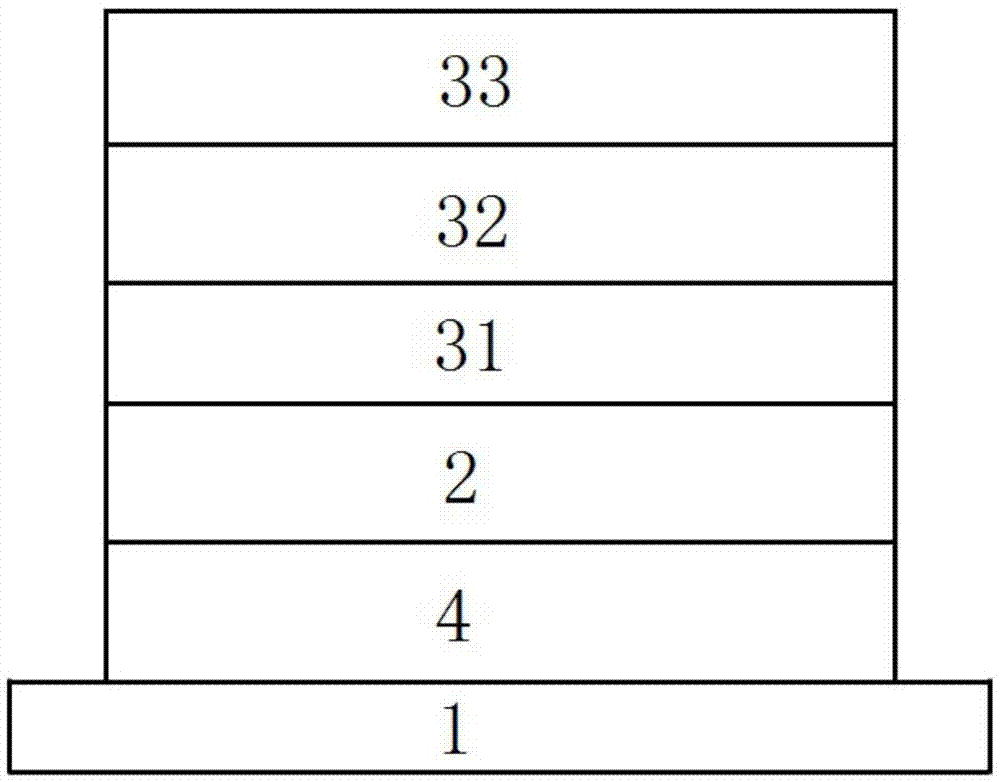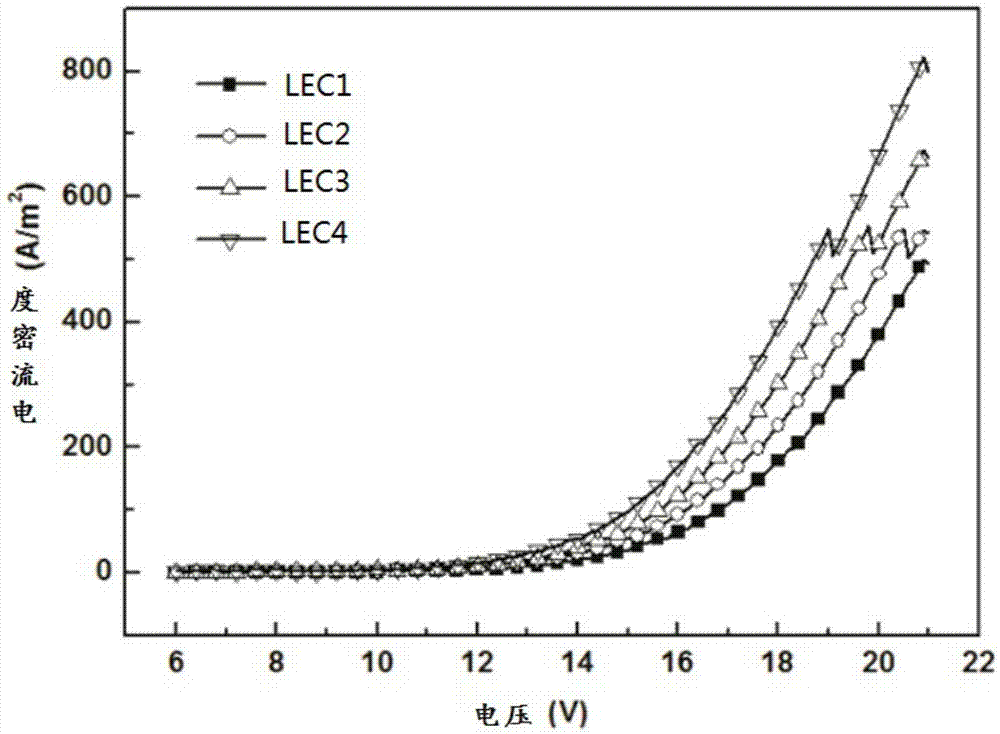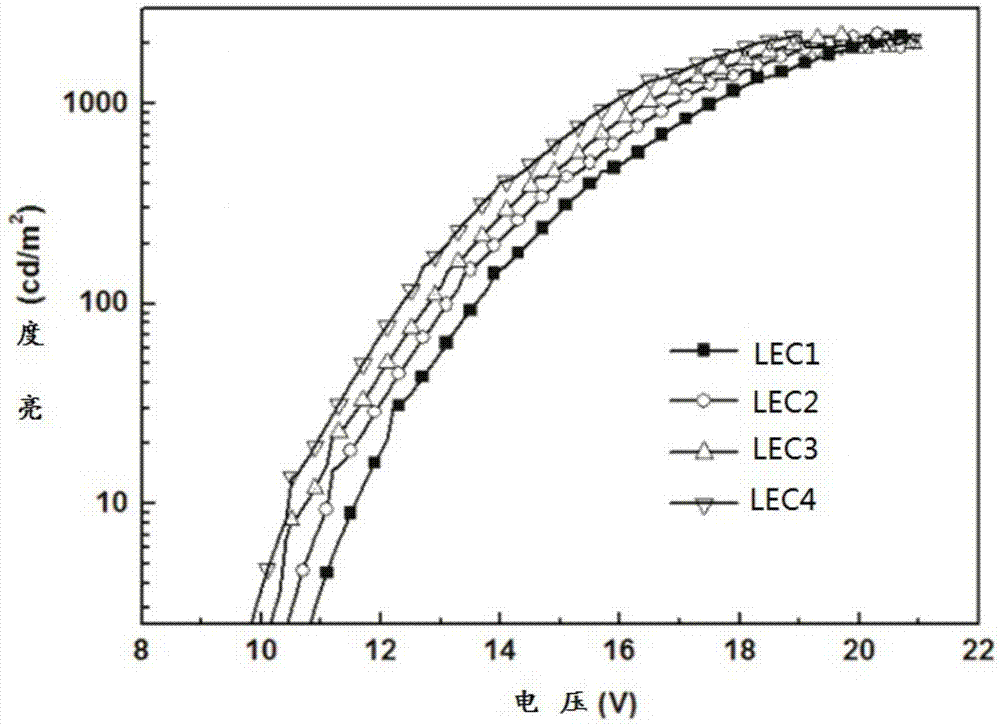Light emitting electrochemical cell and manufacturing method thereof
A light-emitting electrochemical cell and light-emitting layer technology, which is applied to circuits, electrical components, electric solid-state devices, etc., can solve the problems of long response time and low light-emitting brightness of light-emitting electrochemical cells, and achieve the effects of low manufacturing cost and simple process.
- Summary
- Abstract
- Description
- Claims
- Application Information
AI Technical Summary
Problems solved by technology
Method used
Image
Examples
Embodiment 1
[0041] This example provides N^N ligands
[0042] synthetic method.
[0043] (1) The synthesis steps of Pzpy are:
[0044] For details, see He, L., et al. Advanced Functional Materials. 18, 2123-2131 (2008) (He, L., etal. Adv. Funct. Mater. 18, 2123-2131 (2008).):
[0045]
[0046] (2) The synthesis steps of Pyim are:
[0047] For details, see He, L., et al. T Advanced Functional Materials, 19, 2950-2960 (2009) (He, L., etal. Adv. Funct. Mater. 19, 2950-2960 (2009))
[0048]
[0049] (3) The synthesis steps of Ptop are:
[0050]For details, see Zhang, J., et al. Advanced Functional Materials 23, 4667-4677 (2013). (Zhang, J., etal. Adv. Funct. Mater. 23, 4667-4677 (2013))
[0051]
[0052] (4) The synthesis steps of Pop are:
[0053]
Embodiment 2
[0055] The synthesis method of the compound shown in the present embodiment provides formula (1) is:
[0056] Dichloro-bridged diiridium ligand [Ir(dfppy) 2 Cl] 2 (3.100 g, 2.55 mmol) and pzpy ligand (0.743 g, 5.12 mmol) were dissolved in 1,2-ethanediol (60 mL). Under a nitrogen atmosphere, the solution system was refluxed at 140° C. for 12 hours to obtain a clear bright yellow solution. After cooling to room temperature, the Na[B(ArF n ) 4 ] (4.522g, 5.10mmol) was slowly added to the stirring reaction system. The reaction product was filtered with CH 2 Cl 2 Wash and then dry overnight in a vacuum oven at 70°C. The crude product was then chromatographed on a silica gel column (200-300 mesh) using CH 2 Cl 2 As the mobile phase, the formula (1) (5.283 g, 3.34 mmol) was obtained as light yellow powder with a yield of 66%. 1 H-NMR (600MHz, DMSO-d 6 ): δ9.34(d, J=3.1Hz, 1H), 8.55(d, J=8.5Hz, 1H), 8.40-8.36(m, 1H), 8.30(d, J=7.3Hz, 2H), 8.07 (t,J=6.3Hz,2H),7.84(d,J=5.1Hz...
Embodiment 3
[0059] The synthetic method of the compound shown in the present embodiment provides formula (2) is:
[0060] The reactant is [Ir(ppy) 2 Cl] 2 (1.662g, 1.55mmol) and pzpy ligand (0.468g, 3.22mmol), through the same synthetic method as in Example 2, the formula (2) (3.790g, 2.51mmol) of light yellow powder was obtained, and the yield was 81 %. 1H-NMR (600MHz, DMSO-d6): δ9.30(d, J=3.0Hz, 1H), 8.53(d, J=8.5Hz, 1H), 8.35-8.30(m, 1H), 8.26(dd, J=8.0Hz, 3.9Hz, 2H), 7.95(ddd, J=7.7Hz, 3.2Hz, 1.9Hz, 2H), 7.89(dd, J=12.6Hz, 7.8Hz, 2H), 7.77(d, J= 5.7Hz, 1H), 7.71(d, J=5.3Hz, 1H), 7.68(s, 4H), 7.65(d, J=5.6Hz, 1H), 7.61(s, 8H), 7.55-7.51(m, 1H), 7.28(d, J=1.9Hz, 1H), 7.22(t, J=6.7Hz, 1H), 7.18(t, J=6.6Hz, 1H), 7.01(t, J=8.0Hz, 1H) ,6.98(t,J=7.5Hz,1H),6.91-6.87(m,2H),6.84(t,J=7.4Hz,1h),6.19(dd,J=9.6Hz,7.9Hz,2H); 19F -NMR (600MHz, DMSO-d6): δ-61.74 (s, 24F); MS (ESI) [m / z]: [M-B (ArF n ) 4 ]+calcd for C 30 h 23 IrN 5 ,646.16; found, 646.16; [M-Ir(ppy) 2 (pzpy)] - calcd for C ...
PUM
| Property | Measurement | Unit |
|---|---|---|
| Thickness | aaaaa | aaaaa |
| Thickness | aaaaa | aaaaa |
| Thickness | aaaaa | aaaaa |
Abstract
Description
Claims
Application Information
 Login to View More
Login to View More - R&D
- Intellectual Property
- Life Sciences
- Materials
- Tech Scout
- Unparalleled Data Quality
- Higher Quality Content
- 60% Fewer Hallucinations
Browse by: Latest US Patents, China's latest patents, Technical Efficacy Thesaurus, Application Domain, Technology Topic, Popular Technical Reports.
© 2025 PatSnap. All rights reserved.Legal|Privacy policy|Modern Slavery Act Transparency Statement|Sitemap|About US| Contact US: help@patsnap.com



